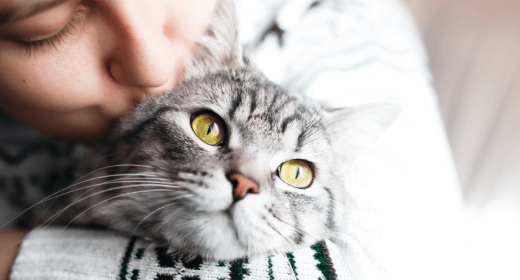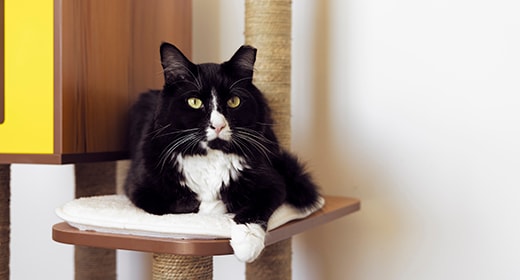

Cats are said to be one of the most intelligent creatures on this planet. They are the ideal embodiment of agility, mobility, speed, and grace. However, between ages 1 to 8, cats go through numerous transitions, equivalent to a teenager transitioning to middle age. As a caregiver, you need to ensure that you provide your cat with everything it needs to stay healthy – rich sources of nutrition, freshwater, etc. A cat's health needs to be monitored closely and any abnormalities should be reported to the vet. In fact, pet parents should care for their cat right from its kitten stage. It will help you keep any older cat health problems at bay in the long run. If you are unaware of how to care for cats between ages one to eight, read on. We made a list of everything that you need to know about caring for a cat!
As a first-time pet parent, it can be difficult to navigate your way through your cat’s needs and wants. Here are a few things you must ensure to keep your cat healthy:
Cats have a habit of licking their fur to groom themselves. This results in the production of hairballs in their system. Brushing or combing your cat daily can help reduce the number of hairballs in its digestive tract. This is a simple way to make grooming easy for your feline friend and help keep its system clean.
Cats are carnivores, they rely on meat as their primary source of nutrition. Pet parents must remember to include meat in their cat’s diet. Avoid feeding dry food in large quantities, as it can have a negative impact on your cat’s health. Cats derive most of their water intake from the food that they consume. Canned foods contain almost 78% water, whereas dry food contains only 5% to 10% water. So, too much dry food or only dry food can leave your cat dehydrated. And dehydration is one of the leading causes of older cat health problems. So, keep your cat nourished and hydrated at all times.
However, when it comes to food, cats can be a tad picky. Some cats prefer dry food over wet food, and vice versa. If you have a cat that feasts on dry cat food, fret not. All you need to do is ensure fresh water is always accessible and provide it with dry foods that are packed with nutrition! At IAMS™, our range of dry cat food not only contains high-quality proteins but also ingredients like Omega 3, fish oil, minerals, and more. We make sure that your cat receives all the right nutrients to have a shiny coat and healthy immune system.
As far as litter boxes go, every cat should have its own. It is also advised for pet parents to keep an additional box for emergency situations. Furthermore, placing litter boxes at the right location is also important. People usually place litter boxes under their furniture, in the basement, or in dark corners. Cats may not always be comfortable with such settings. They prefer having an eye on their surroundings while doing the business. So, if you notice that your cat is not using the litter box, try changing its location.
It is frustrating when your cat does not use the litter box and dirties other areas of your home. The best way to resolve this issue is by finding out why it is doing so. First, take your cat to the vet to rule out any cat health problems like urinary tract infections. If illnesses are not the root cause, try changing the location as well as the litter box.
Another issue that pet parents face is their cat scratching different surfaces or ripping home decor fabric to shreds. Scratching is an instinctive behavior for cats. They do so to express different emotions. Many cat parents are oblivious to the fact that their pet needs a scratching post. Place it in a spot where your cat can easily notice it. You can also sprinkle some catnip on the post to attract your cat.
Neutering or spaying your cat is beneficial in multiple ways. Cats generally get aggressive as they go into heat. Female cats are very uncomfortable during this period, and unneutered male cats tend to fight with each other. These fights can also result in the transmission of diseases through scratches and bites. Other than that, female cats can conceive at just four months of age, and raising a kindle of kittens can be stressful.
If you are a new cat parent, you must keep an eye out for common cat health issues. Going for routine health check-ups is highly recommended so that you can spot any early signs of kitten health problems.
Vomiting is one of the most common cat health issues and it can happen due to many reasons. Your cat can vomit because of hairballs, eating something inedible, diabetes, urinary tract infection, etc. If you notice your cat heaving abdominally or drooling, take it to the vet immediately.
Fleas bother almost all furry pets and are a common cat health problem. Fortunately, this is a problem that can be treated easily. Look out for signs such as:
Hair loss
Skin infections
Excessive scratching and itching
Frequent licking
Regardless of any signs, pet parents are recommended to get their cats checked for fleas regularly.
Female and male cats who are unfit, overweight, or consume a lot of dry food tend to get FLUTD. Co-existing with multiple cats, sudden lifestyle changes, and stress can also influence the occurrence of this disease. Here are a few symptoms that cat parents can look out for:
Dehydration
Loss of appetite
Frequent vomiting
Visible discomfort while urinating
Licking around the genitalia
Blood in their urine
Urinating outside the litter box
Your vet can recommend the right treatment according to the type of FLUTD your cat has.
Eye problems can occur because of many reasons such as glaucoma, cataracts, conjunctivitis, inflammation, different viruses, retinal diseases, and trauma. Symptoms that suggest eye problems include watery eyes, red eyes, gunk deposits in one or both eyes, cloudiness, white or red lining, and squinting. The best you can do is wipe off any dirt or gunk from your cat’s eyes and take it to the vet.
Eating spoiled foods, liver diseases, cancer, infection, and other health issues can cause diarrhoea in cats. Common symptoms of diarrhoea are watery or loose stools. This condition can last for days, weeks, or months, depending on the cause. If your cat is suffering from this condition, make sure you provide it with a lot of fresh water and take it to the vet.
You now know how to provide and care for your cat, and what problematic signs you need to look out for. Now let’s explore the signs of good cat health:
Here are 5 signs of good cat health:
Here are some common cat health issues:
If you want to maintain your cat’s health, take your pet to the vet regularly for an annual medical examination. Along with periodic health check-up, ensure that you:
To monitor your cat’s health, look for signs of illnesses like vomiting, diarrhoea, and problems during urination. These symptoms suggest that your cat might be falling sick. Signs such as good sleep, healthy appetite, and a playful attitude suggest that your cat is healthy.


Cats are generally considered to be low-maintenance pets. However, that’s nothing but a myth. You need to care for a cat the way you would care for any baby, especially with regards to its health and overall well-being. Although medical treatments are available for most feline illnesses, prevention is always better than cure. Cat vaccinations, such as the anti-rabies and FVRCP vaccine, protect your furry friends from deadly infections like rabies. But did you know? These diseases are transmissible to humans as well. Yes. So, when you vaccinate your cat against such medical conditions, you also reduce the possibility of contracting fatal diseases from your own pet.
Feline vaccines are scientifically developed to boost the cat’s immunity and fight fatal diseases. Even though there is no ‘one size fits all’ protocol for immunization, veterinarians suggest cat injections depending on your pet’s age, overall health, lifestyle, and breed. Moreover, these vaccinations are primarily divided into two categories – core vaccines and lifestyle vaccines. Core vaccines are essential for every cat irrespective of their lifestyle, breed, and region. Lifestyle vaccines are given to cats after considering certain circumstances.
Administering rabies and other precautionary vaccines from a young age protects cats from falling prey to serious diseases. Mentioned below are essential cat vaccinations that every kitty must get:
These are anti-rabies vaccines for cats. They are given annually or once in 3 years – depending on the type of vaccine you choose – to protect your kitty from the fatal rabies virus. While this disease is fatal for your feline friend, it can also prove terminal for humans. Rabies often spreads through bites or scratches of infected animals. And rabies patients develop signs of aggression, disorientation, and hydrophobia post incubation stage. If not treated in time, rabies often results in fatal consequences for both animals and humans. Hence, anti-rabies vaccines for cats are a must from a young age.
These are 3-in-1 vaccine for cats. FVRCP vaccine prevents cats from three different viruses – feline rhinotracheitis virus, calicivirus, and feline panleukopenia virus. Instead of getting the kitten inoculated three times, you can simply get the FVRCP vaccine. This 3-in-1 vaccine for cats is recommended annually to protect them from highly infectious diseases.
Protect your kitty from leukemia virus by getting them vaccinated. This disease can spread through body fluids like urine, saliva, and feces; hence, FeLV infects cats while grooming or sharing a bowl with an infected cat. This fatal virus can process into various associated conditions such as anemia, lymphoma, or immunosuppression. Hence, the FeLV vaccine is recommended for cats from a very young age. This vaccine consists of two doses spaced three to four weeks apart for kittens and is followed by revaccination a year later for adult cats.
An FPV vaccine also protects your cat from feline panleukopenia. Kittens should receive an FPV shot once they turn 6-8 weeks old. You should also revaccinate your four-legged angel every three to four weeks until the age of 16 weeks. After this, a booster dose should be given between the ages of 1 to 2 years.
Developed to combat 4 diseases, 4-in-1 vaccine for cats protect against rhinotracheitis, calicivirus, panleukopenia, and chlamydia. These 4 in 1 cat vaccine are also called 4-way vaccines or FVRCCP. Feline chlamydia is part of the feline upper respiratory complex and an underlying cause of most early ocular infections. Hence, kittens should receive 4-in-1 vaccine for cats at the age of 8, 12, and 16 weeks, and a revaccination once they turn a year old. Cat parents are also suggested to revaccinate their kitty every 3 years to keep their purrfect pal hale and hearty.
F5 or Fevac 5 vaccines are 5-in-1 vaccine for cats that boosts your kitty’s immune system to tackle five viruses. Getting your kitty inoculated for this combination will ensure that it is safe from a range of fatal illnesses.
Vaccines are built to boost immunity and fight deadly illnesses. However, after getting vaccinated, your kitty might show mild signs of discomfort and other symptoms. These signs and symptoms are nothing but proof that its body is building a defense mechanism to defeat deadly viruses. Side effects of anti-rabies, FVRCP vaccine, or other combination vaccines for cats may include the following symptoms:
Lethargy
Loss of appetite
Vomiting
Fever
Diarrhea
Ensuring that your feline friend is vaccinated from time to time aids in keeping them healthy and lively. Hence, every cat parent is recommended to plan a proper vaccination schedule for their fur babies.